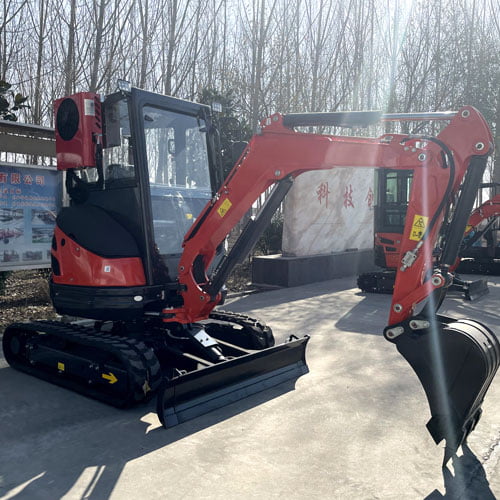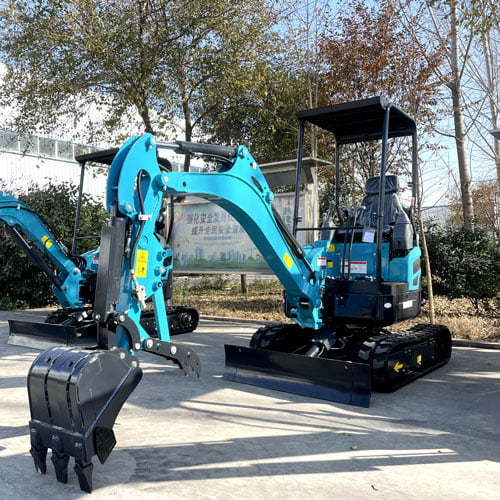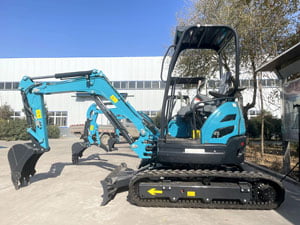Inleiding
Het bedienen van een minigraafmachine kan een zeer efficiënte manier zijn om kleine tot middelgrote graafprojecten aan te pakken. Of u nu een doe-het-zelver bent die thuisprojecten aanpakt of een professionele gebruiker, het is van cruciaal belang dat u de basisprincipes van het bedienen van deze veelzijdige machine begrijpt. In deze gids gaan we dieper in op de stappen en best practices voor het effectief en veilig bedienen van een minigraafmachine. Dit omvat het begrijpen van de onderdelen van de machine, het leren van de bedieningselementen en het volgen van essentiële veiligheidsprotocollen. Aan het eind van dit artikel weet u hoe u een minigraafmachine moet bedienen.
Understanding the Components of a Minigraafmachine

Before you start operating a mini excavator, it’s essential to familiarize yourself with its main components. Knowing these parts and their functions will not only make your operation more efficient but also ensure safety and longevity for the machine. Here’s a detailed look at the key components of a mini excavator:
Cab
The cab is where the operator sits and controls the excavator. It is designed to be ergonomically comfortable and provides a clear view of the work area. Modern cabs often come equipped with climate control, adjustable seats, and advanced control panels to enhance operator comfort and efficiency. Inside the cab, you will find various controls, including joysticks, foot pedals, and a dashboard displaying important information such as fuel levels, engine temperature, and other critical indicators.
Boom
The boom is the long arm attached to the cab that holds the bucket. It is one of the most critical parts of the excavator as it allows the operator to reach out and dig into the ground. The boom is typically hydraulically operated, enabling smooth and precise movements. Depending on the model of the mini excavator, the boom can vary in length and flexibility, with some models offering an offset or swing boom feature for better maneuverability in tight spaces.
Emmer
The bucket is the attachment used for digging and moving materials. It comes in various sizes and shapes, each designed for specific tasks. Common types of buckets include digging buckets, grading buckets, and trenching buckets. The bucket is connected to the boom and stick (another part of the arm) and can be easily changed out depending on the job requirements. Buckets are made of durable materials to withstand the rigors of excavation work and often have reinforced edges to improve their lifespan.
Tracks
Tracks are the continuous belts that allow the excavator to move. Unlike wheels, tracks provide better stability and traction, especially on uneven or muddy terrain. They are made from high-strength rubber or steel and are designed to distribute the machine’s weight evenly, minimizing ground pressure. This feature makes mini excavators particularly effective in delicate environments where minimal ground disturbance is necessary. Regular inspection of tracks for wear and tear is essential to ensure smooth operation.
Counterweight
The counterweight is a weight at the rear of the excavator that helps balance the machine, especially when lifting heavy loads with the boom and bucket extended. It prevents the excavator from tipping over and enhances stability during operation. The counterweight is crucial for maintaining the center of gravity, making it safer to operate the machine in various conditions. In some models, the counterweight can be adjusted or removed to facilitate easier transport of the excavator.
Control Levers and Pedals
Control levers and pedals are used to operate the boom, bucket, and tracks. The right joystick typically controls the boom and bucket, while the left joystick manages the swing and stick movements. Foot pedals are used to control the tracks, allowing the excavator to move forward, backward, and pivot. Understanding and mastering these controls is essential for precise and efficient operation. The layout of these controls may vary slightly depending on the manufacturer, but the basic functions remain consistent.
Hydraulisch systeem
The hydraulic system is the powerhouse of the mini excavator, driving the movement of the boom, stick, and bucket. It consists of hydraulic pumps, cylinders, and hoses that convert mechanical energy into hydraulic energy, enabling powerful and precise operations. Regular maintenance of the hydraulic system, including checking fluid levels and inspecting for leaks, is critical for the smooth functioning of the excavator.
Motor
The engine provides the necessary power to operate the mini excavator. It is typically located at the rear of the machine and is designed to be fuel-efficient while delivering high performance. Modern mini excavators often come with diesel engines that offer a good balance of power and fuel economy. Regular maintenance of the engine, such as oil changes and air filter replacements, is essential to ensure long-term reliability and performance.
Undercarriage
The undercarriage supports the entire structure of the excavator and houses the tracks and drive components. It is designed to withstand the harsh conditions of construction sites, providing stability and durability. Regular inspection of the undercarriage for signs of wear and damage is important to maintain the excavator’s performance and safety.
Understanding these components will help you in the operational steps that follow.
Getting Started: Pre-Operation Checklist
Before operating a mini excavator, perform a thorough inspection to ensure the machine is in good working condition. Here’s a checklist to follow:
- Check Fluid Levels: Ensure that hydraulic fluid, engine oil, and coolant levels are adequate.
- Inspect the Tracks: Look for any damage or wear on the tracks.
- Test the Controls: Make sure all control levers and pedals are functioning properly.
- Examine the Bucket: Check for any cracks or damage.
- Safety Gear: Wear appropriate safety gear including a hard hat, safety gloves, and boots.
Completing this checklist will help prevent accidents and prolong the life of your mini excavator.
Operating the Minigraafmachine: Step-by-Step Guide

Starting the Excavator
- Enter the Cab: Use the handrails and steps to safely enter the cab.
- Fasten the Seatbelt: Ensure you are securely fastened before starting the machine.
- Start the Engine: Insert the key into the ignition and turn it to start the engine.
- Warm Up the Engine: Allow the engine to warm up for a few minutes before operating.
Using the Controls
- Joystick Controls: Use the right joystick to control the boom and bucket. Push forward to lower the boom and pull back to raise it. Move left and right to tilt the bucket.
- Left Joystick: This controls the swing and stick. Push forward to extend the stick and pull back to retract it. Move left and right to rotate the cab.
- Foot Pedals: Use the foot pedals to control the tracks. Press forward to move forward and backward to reverse.
Digging and Moving Materials
- Positioning: Position the excavator close to the digging area with the tracks parallel to the trench.
- Digging: Lower the boom and tilt the bucket to scoop up the material.
- Lifting: Raise the boom and move the joystick to swing the cab to the desired location.
- Dumping: Tilt the bucket to release the material.
Shutting Down the Excavator
- Park the Excavator: Move the machine to a safe parking area.
- Lower the Boom and Bucket: Ensure the boom and bucket are on the ground.
- Turn Off the Engine: Turn the key to shut off the engine.
- Exit the Cab: Safely exit the cab using the handrails and steps.
Safety Tips and Best Practices
Operating a mini excavator requires adherence to safety protocols to prevent accidents and injuries. Here are some essential safety tips:
- Always Wear Safety Gear: Use a hard hat, safety gloves, and boots.
- Be Aware of Your Surroundings: Always check for obstacles and other workers.
- Follow Load Limits: Do not exceed the machine’s load capacity.
- Use Stabilizers: Deploy the stabilizers for added balance when necessary.
- Regelmatig onderhoud: Keep the excavator well-maintained to ensure safe operation.
Common Issues and Troubleshooting
Even with proper maintenance, you might encounter some issues while operating a mini excavator. Here are some common problems and their solutions:
| Issue | Possible Cause | Solution |
|---|---|---|
| Engine won’t start | Low fuel, dead battery | Check fuel level, charge or replace battery |
| Hydraulic system failure | Low hydraulic fluid, filter blockage | Check fluid levels, clean or replace filters |
| Unresponsive controls | Mechanical linkage issue | Inspect and repair linkage |
| Overheating | Coolant level low, radiator blocked | Refill coolant, clean radiator |
Understanding these common issues can help you troubleshoot effectively and minimize downtime.
Conclusie
Operating a mini excavator efficiently and safely requires a good understanding of the machine’s components, proper pre-operation inspection, and knowledge of the controls. By following the guidelines outlined in this article, you can ensure that you are operating the mini excavator correctly and safely. Regular maintenance and adherence to safety protocols will not only extend the life of your machine but also help prevent accidents. Whether you are new to using mini excavators or looking to improve your skills, this guide on how to operate a mini excavator provides a comprehensive resource to help you succeed in your projects.
FAQ
What are the basic steps to operate a minigraafmachine?
To operate a mini excavator, you need to start with a pre-operation inspection, familiarize yourself with the controls, and follow a step-by-step guide for starting, operating, and shutting down the machine.
How do you dig efficiently with a mini excavator?
Position the excavator correctly, use the joystick controls to lower the boom and bucket, and scoop up the material. Lift and swing the cab to the dumping area, then tilt the bucket to release the material.
Welke veiligheidsmaatregelen moet ik nemen bij het bedienen van een minigraafmachine?
Always wear appropriate safety gear, be aware of your surroundings, follow the machine’s load limits, use stabilizers, and keep the excavator well-maintained.
How often should I perform maintenance on a mini excavator?
Regular maintenance should be performed based on the manufacturer’s recommendations, typically every 250-500 hours of operation. This includes checking fluid levels, inspecting tracks, and cleaning filters.
What should I do if the minigraafmachine’s engine overheats?
If the engine overheats, immediately stop the machine and check the coolant level. Refill if necessary and inspect the radiator for any blockages. Allow the engine to cool down before resuming operation.




